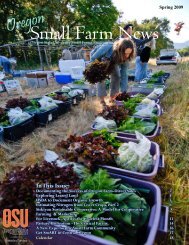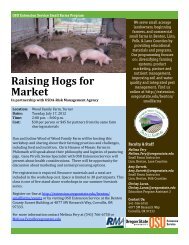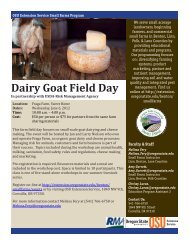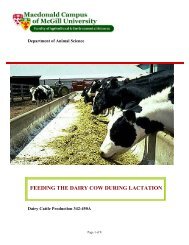Small Farm News - Oregon Small Farms - Oregon State University
Small Farm News - Oregon Small Farms - Oregon State University
Small Farm News - Oregon Small Farms - Oregon State University
You also want an ePaper? Increase the reach of your titles
YUMPU automatically turns print PDFs into web optimized ePapers that Google loves.
The effects of compaction, although mediated by<br />
some management techniques, are difficult to reverse.<br />
The most obvious culprit of compaction is heavy<br />
machinery and tillage implements. High animal traffic<br />
can also lead to compacted trails or areas around feed<br />
or watering troughs, which reduce available forage.<br />
When a soil is moist, the effects of these practices on<br />
soil compaction are even more pronounced.<br />
A soil does not have to be completely saturated to be<br />
vulnerable to compaction. While clay soils are more<br />
vulnerable to compaction, sandy soils can also be<br />
susceptible given improper management. Checking<br />
the moisture conditions of your soil before cultivating<br />
will pay off in the long run. As a general rule, soils are<br />
too moist for cultivation if they fail the ribbon test or<br />
the ball test. For the ribbon test, push the soil between<br />
your thumb and forefinger. If the ribbon breaks before<br />
1-2 inches, there is less risk of compaction, but if you<br />
form a ribbon form 4-5 inches, the soil is too wet for<br />
cultivation. For another test, form the soil into a 2<br />
inch ball. If the ball holds together when thrown into<br />
the air, then it is also too moist for cultivation. Soil<br />
moisture probes are also available to help determine<br />
when the soil water content is too high for cultivation.<br />
Determining soil moisture by feel is really more of an<br />
art than a science. The importance of not cultivating<br />
a wet soil cannot be overemphasized. When in doubt,<br />
waiting a day or two is your best protection against<br />
inadvertently damaging the structure of your soil.<br />
Pugging<br />
Wet soils are also extremely susceptible to pugging<br />
by animals. This occurs when animal hooves break<br />
through the soil surface, which is less stable when<br />
saturated. This trample results in burying or uprooting<br />
of pasture plants. Localized compaction also occurs<br />
and further comprises pasture productivity. The<br />
resulting pugging damage can decrease pasture<br />
productivity from 20-80% for the year after the initial<br />
damage occurs and up to 20% after pastures appear<br />
to have recovered. The unevenness of the pasture<br />
surface also reduces forage utilization by animals.<br />
Additionally, undesirable weedy species are better able<br />
to compete with desired pasture species after pugging<br />
damage.<br />
To avoid pugging, it is important to recognize the<br />
moisture condition of pasture soils. Under very<br />
wet conditions, it may be advisable to keep animals<br />
off pastures entirely. Other options include moving<br />
electric fences more frequently or increasing the<br />
paddock area. Hardening high traffic areas can also<br />
improve conditions for animals.<br />
Timing is also an important factor in preventing<br />
pasture pugging. The resiliency of a pasture is affected<br />
by its vegetative cover, with bare soils being more<br />
susceptible to pugging. For this reason, the strength of<br />
grass roots, which increases with new pasture growth<br />
in the spring, is an important consideration in timing<br />
turning animals out in pasture to prevent pugging.<br />
Since seasonal variations in rainfall as well as previous<br />
year’s grazing affect the strength of pasture roots, there<br />
is no definitive time to let animals out on pasture. The<br />
best rule of thumb is to perform a pull test on your<br />
pasture plants. If they are easily uprooted by pulling,<br />
then they are probably too fragile for grazing. If<br />
grazed too soon, then the resulting bare patches are<br />
more susceptible to pugging in the event of spring<br />
rains.<br />
Conclusion<br />
Watching the water on your landscape during a<br />
long, wet spring offers insights into inherent soil<br />
and topographic variability, as well as management<br />
challenges and opportunities. Wet pastures and<br />
fields are also extremely susceptible to damage<br />
from compaction due to animals and machinery, as<br />
well as reduced pasture productivity from pugging.<br />
Appropriate timing of spring cultivation and grazing<br />
due to wet conditions, however, is essential to<br />
preserving long-term soil productivity and preventing<br />
the necessity of costly remediation efforts.<br />
Additional resources:<br />
http://offices.ext.vt.edu/carroll/programs/anr/forages/<br />
pugged_pastures_spring2010.pdf<br />
http://www.extension.umn.edu/distribution/cropsystems/<br />
dc3115.html<br />
http://www.extension.iastate.edu/publications/pm1901b.<br />
pdf<br />
<strong>Oregon</strong> <strong>Small</strong> <strong>Farm</strong> <strong>News</strong> Vol. VII No. 2 Page 17















